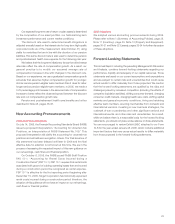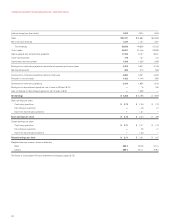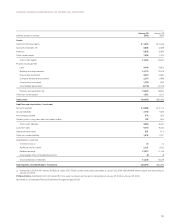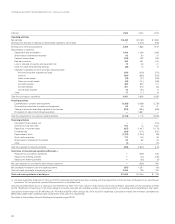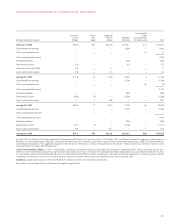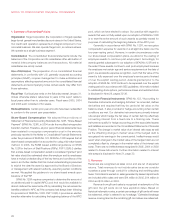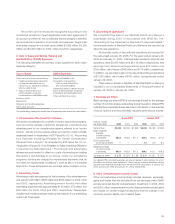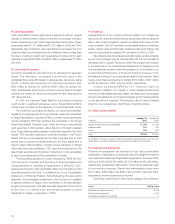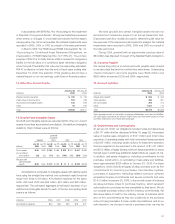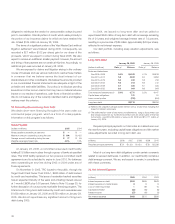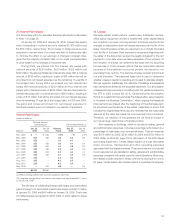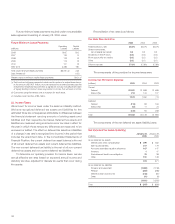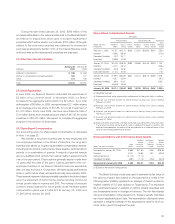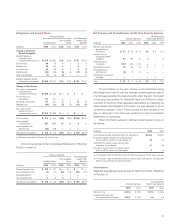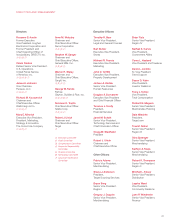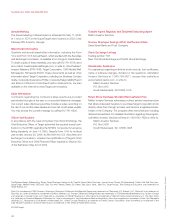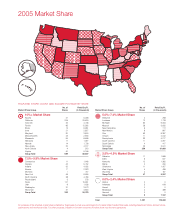Target 2005 Annual Report Download - page 35
Download and view the complete annual report
Please find page 35 of the 2005 Target annual report below. You can navigate through the pages in the report by either clicking on the pages listed below, or by using the keyword search tool below to find specific information within the annual report.
33
21. Interest Rate Swaps
Our accounting policy for derivative financial instruments is discussed
in Note 1 on page 28.
At January 28, 2006 and January 29, 2005, interest rate swaps
were outstanding in notional amounts totaling $3,300 million and
$2,850 million, respectively. The increase in swap exposure was
executed to convert more of our fixed-rate debt to floating-rate debt
to minimize the effect on our earnings of changes in interest rates,
given that the majority of interest rates on our credit card receivables
re-price based on the changes in the prime rate.
During 2005, we entered into four interest rate swaps with
notional amounts of $250 million, $350 million, $325 million and
$225 million. We also terminated an interest rate swap with a notional
amount of $200 million, resulting in a gain of $24 million that will be
amortized into net interest expense over the remaining 13-year life of
the hedged debt. During 2004, we entered into two interest rate
swaps with notional amounts of $200 million and two interest rate
swaps with notional amounts of $250 million. We also terminated an
interest rate swap with a notional amount of $200 million, resulting in
a loss of $16 million that will be amortized into net interest expense
over the remaining 14-year life of the hedged debt. In 2005 and 2004,
the gains and losses amortized into net interest expense for
terminated swaps were not material to our results of operations.
Interest Rate Swaps
(dollars in millions)
Notional Amount
Outstanding at Pay Floating Rate at (a)
Jan. 28, Jan. 29, Receive Jan. 28, Jan. 29,
Maturity 2006 2005 Fixed 2006 2005
Feb. 2005 $— $ 500 7.5% —% 2.4%
May 2006 550 550 4.6 4.8 3.3
Mar. 2008 250 —3.9 4.4 —
Mar. 2008 250 250 3.8 4.4 2.4
Oct. 2008 500 500 4.4 4.8 3.2
Oct. 2008 250 250 3.8 4.4 2.5
Nov. 2008 200 200 3.9 4.4 2.4
Jun. 2009 400 400 4.4 4.8 3.3
Jun. 2009 350 —4.2 4.5 —
Aug. 2010 325 —4.8 4.5 —
Aug. 2010 225 —4.5 4.5 —
May 2018 —200 5.8 — 3.3
$3,300 $2,850
(a) Reflects floating interest rate as of the respective year-end.
The weighted average life of the interest rate swaps was approximately 2.7 years
at January 28, 2006.
The fair value of outstanding interest rate swaps and unamortized
gains/(losses) from terminated interest rate swaps was $(21) million
at January 28, 2006 and $45 million at January 29, 2005. There was
no ineffectiveness recognized in 2005, 2004 or 2003 related to these
instruments.
22. Leases
We lease certain retail locations, warehouses, distribution centers,
office space, equipment and land. Assets held under capital leases
are included in property and equipment and lease payments are
charged to depreciation and net interest expense over the life of the
lease. Operating lease rentals are expensed on a straight-line basis
over the life of the lease. Rent expense is recognized beginning with
the earlier of the date when we become legally obligated for the rent
payments or the date when we take possession of the property. At
the inception of a lease, we determine the lease term by assuming
the exercise of those renewal options that are reasonably assured
because of the significant economic penalty that exists for not
exercising those options. The exercise of lease renewal options is at
our sole discretion. The expected lease term is used to determine
whether a lease is capital or operating and is used to calculate straight-
line rent expense. Additionally, the useful life of buildings and leasehold
improvements are limited by the expected lease term. Our amortization
of leasehold improvements is consistent with the guidance issued by
the EITF in 2005 in Issue No. 05-6, “Determining the Amortization
Period for Leasehold Improvements Purchased after Lease Inception
or Acquired in a Business Combination,” which requires that leasehold
improvements purchased after the beginning of the initial lease term
be amortized over the shorter of the assets’ useful lives or a term that
includes the original lease term plus any renewals that are reasonably
assured at the date the leasehold improvements are purchased.
Therefore, our adoption of this guidance did not have an impact in
our net earnings, cash flows or financial position.
Rent expense on buildings, which is included in selling, general
and administrative expenses, includes percentage rents based on a
percentage of retail sales over contractual levels. Total rent expense
was $154 million in 2005, $240 million in 2004 and $150 million in
2003. Refer to Note 29, page 39 for discussion of the 2004 lease
accounting adjustment. Certain leases require us to pay real estate
taxes, insurance, maintenance and other operating expenses
associated with the leased premises. These amounts are not included
in rent expense but are classified in selling, general and administrative
expenses consistent with similar costs for owned locations. Most long-
term leases include options to renew, with terms varying from one to
50 years. Certain leases also include options to purchase the property.


